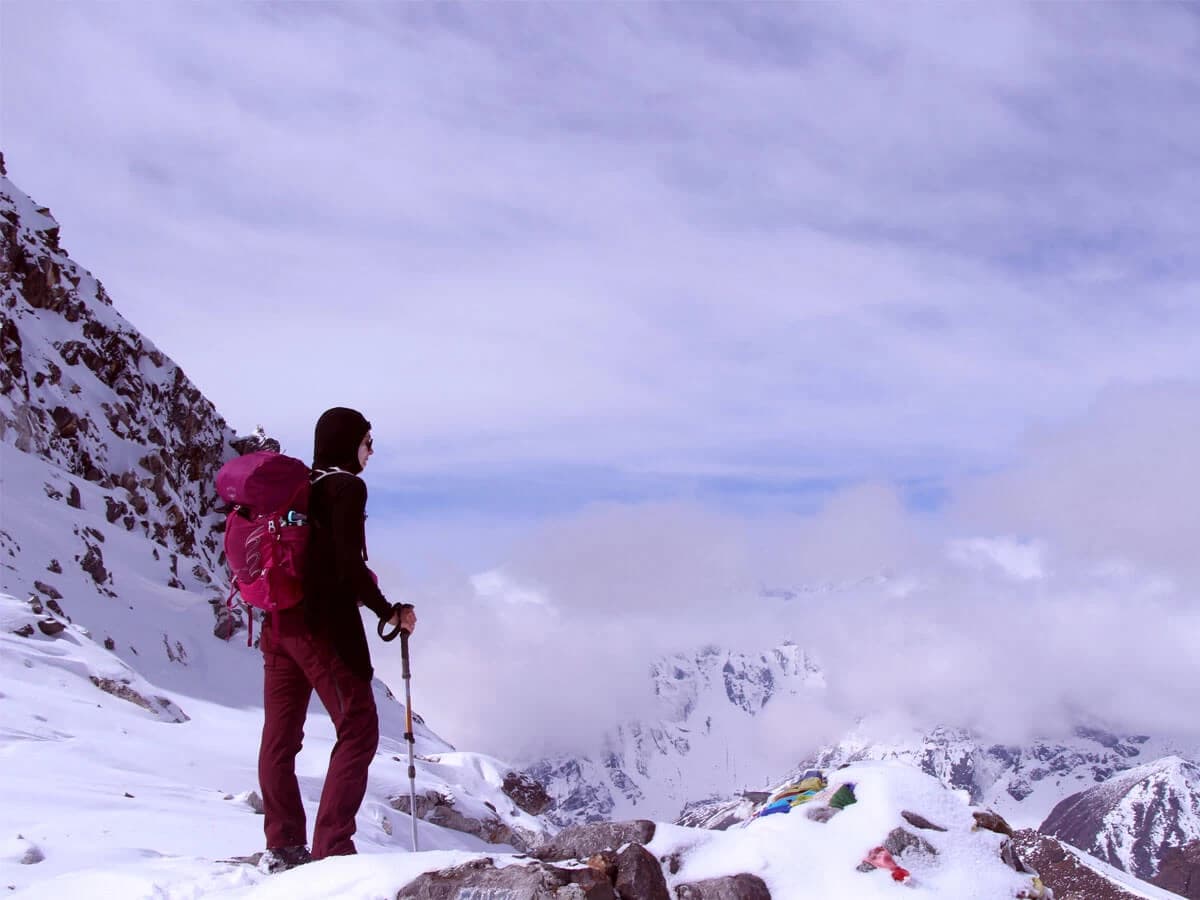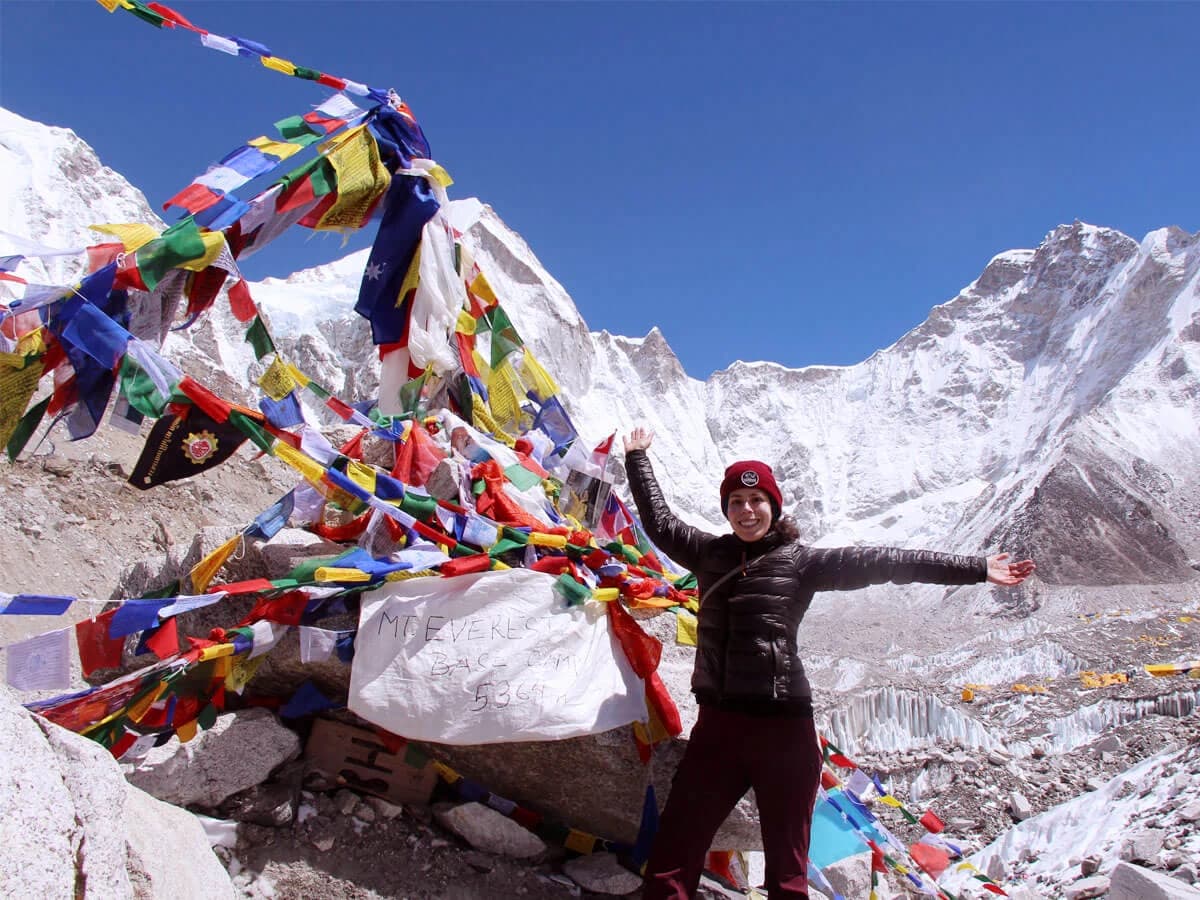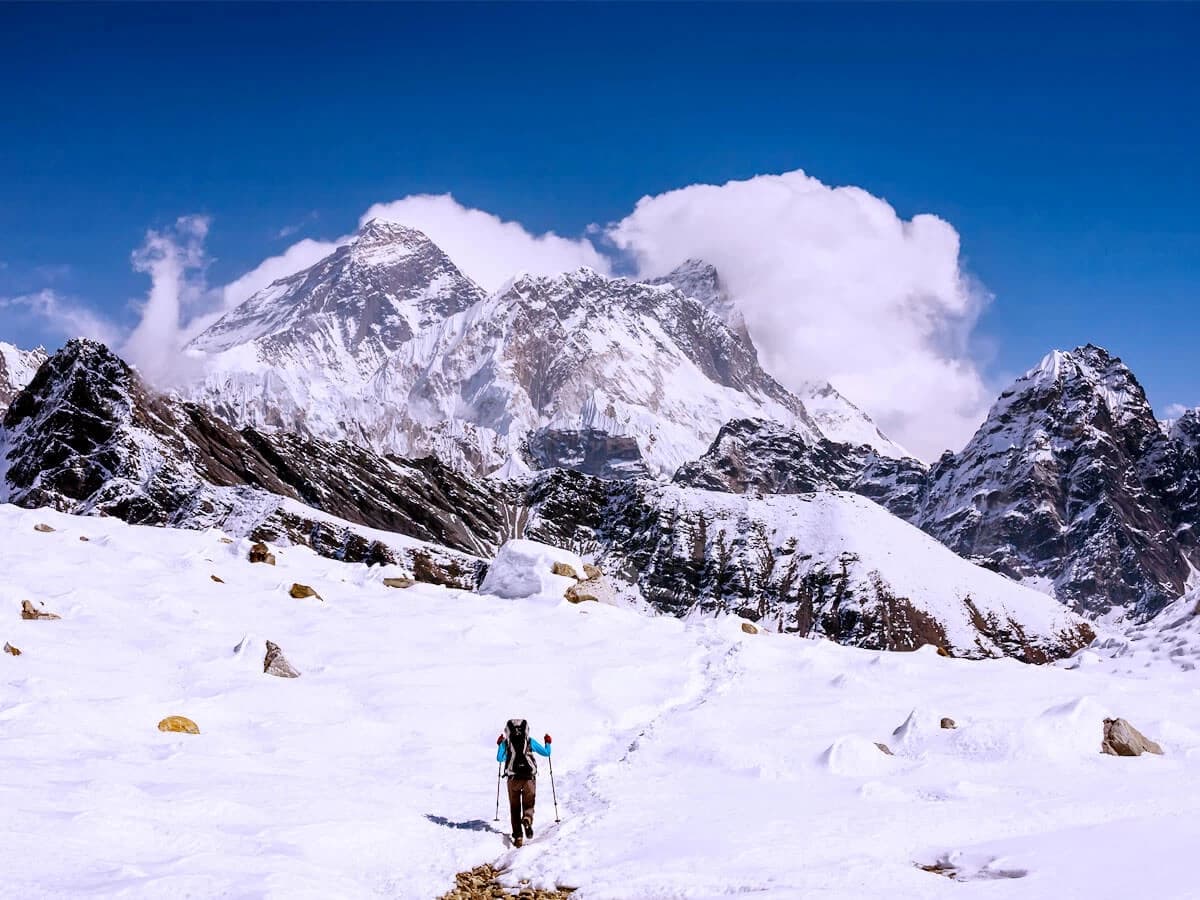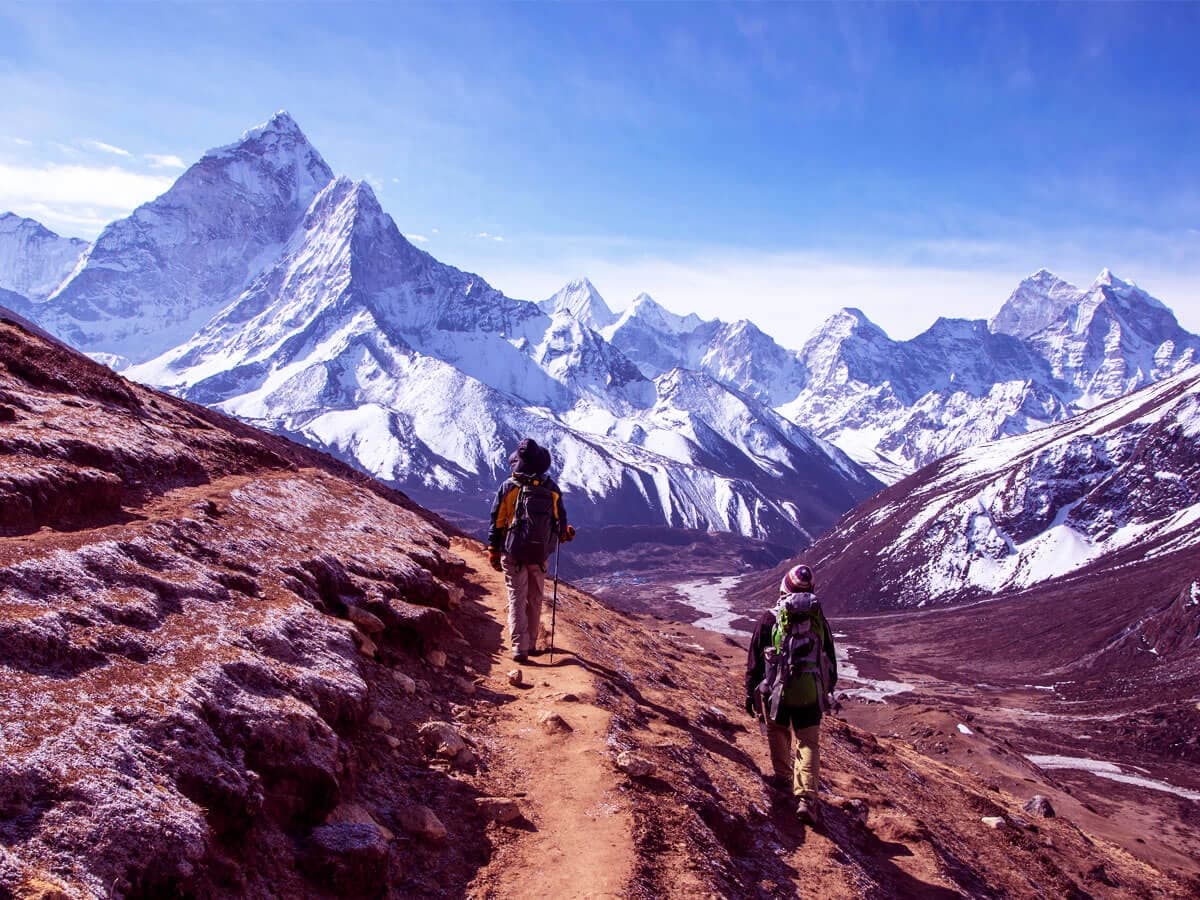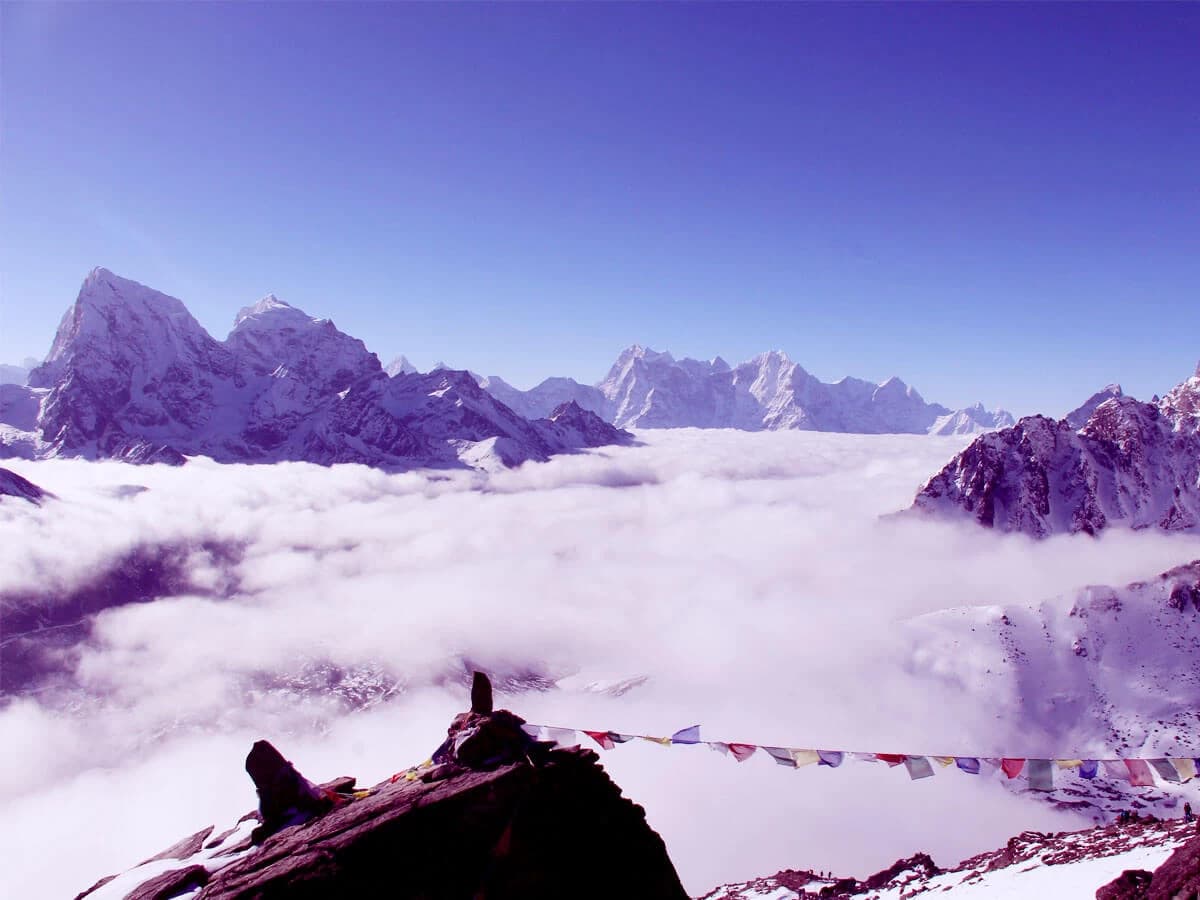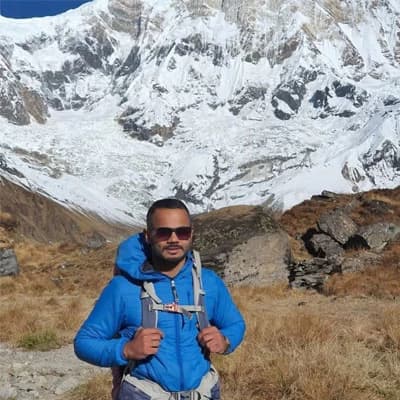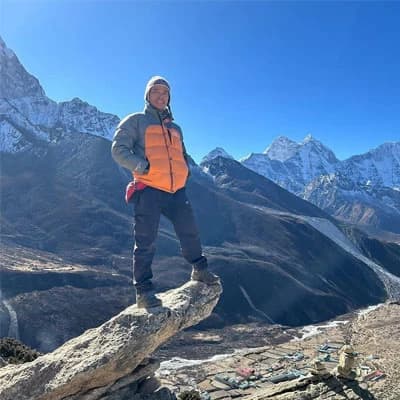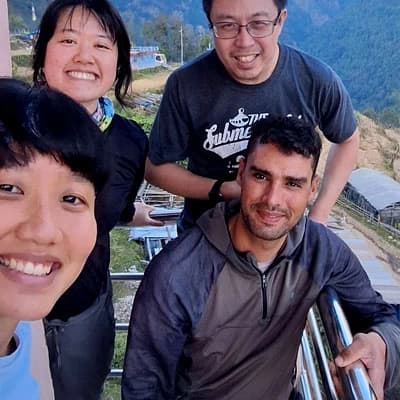The Everest Three High Passes Trek is a challenging journey through the Khumbu region’s three iconic high-altitude passes: Kongma La (5,535m), Cho La (5,420m), and Renjo La (5,360m). This trek offers an unparalleled adventure, combining dramatic Himalayan landscapes with panoramic views of Everest, Lhotse, Makalu, Cho Oyu, and Ama Dablam. Along the way, you will explore vibrant Sherpa villages like Namche Bazaar and Dingboche, visit the historic Tengboche Monastery, and experience the rich biodiversity of Sagarmatha National Park. With a visit to Everest Base Camp and the pristine Gokyo Lakes, the Everest Region Three High Passes Trek offers a complete adventure for seasoned trekkers.
Everest Three High Pass Trek
The Everest Three High Passes Trek is the ultimate adventure for thrill-seekers and experienced trekkers looking to push their limits in the heart of the Himalayas. The trail takes you on an exhilarating journey across three high-altitude passes: Kongma La (5,535m), Cho La (5,420m), and Renjo La (5,360m), each offering jaw-dropping views of Everest, Lhotse, Makalu, Cho Oyu, and countless other majestic peaks.
Everest Three Pass trek passes through Sagarmatha National Park, a UNESCO World Heritage Site, renowned for its diverse flora and fauna, including Himalayan thar and snow leopards. Along the way, you will visit ancient monasteries like Tengboche and Pangboche, where Buddhist traditions and rituals create a serene ambiance amidst the wild.
The Everest Base Camp Three High Passes Trek also combines iconic highlights such as Everest Base Camp, the mesmerizing turquoise Gokyo Lakes, and the renowned Kala Patthar viewpoint, making it one of the most comprehensive adventures in the Everest region.
The adventure begins with a thrilling flight to Lukla, followed by an ascent through picturesque Sherpa villages, dense pine and rhododendron forests, and suspension bridges that sway above roaring rivers.
The first highlight is Namche Bazaar, the vibrant Sherpa trading hub nestled in the lap of the Himalayas. Trekkers spend an acclimatization day here, exploring its bustling markets, cozy teahouses, and nearby viewpoints like Syangboche, where breathtaking panoramas of Everest, Ama Dablam, and Thamserku await.
As the trek progresses, you will cross Kongma La, the first of the three passes, offering panoramic vistas of the Everest massif. Continuing onward, the journey leads to Everest Base Camp and Kala Patthar, where you will be rewarded with an unforgettable sunrise over the world’s highest peaks.
The adventure intensifies with the crossing of Cho La Pass, taking you into the stunning Gokyo Valley. Here, you will marvel at the serene Gokyo Lakes and hike up Gokyo Ri (5,357m) for a sweeping view of the turquoise lakes surrounded by towering peaks. Renjo La, the final pass, offers one last incredible view of the Himalayas before descending into the serene village of Thame.
This demanding trek is perfect for seasoned adventurers seeking an unparalleled Himalayan experience. It combines thrilling challenges, breathtaking scenery, and immersive cultural encounters, making the Everest Three High Passes Trek an unforgettable journey through one of the most remote and awe-inspiring regions on Earth.
Highlights
- Thrilling flight to Lukla, one of the world’s most exciting and scenic air journeys.
- Crossing three high-altitude passes: Kongma La (5,535m), Cho La (5,420m), and Renjo La (5,360m), each offering unique panoramic views of the Himalayas.
- Panoramic views of Mount Everest, Lhotse, Nuptse, Makalu, Cho Oyu, Ama Dablam, and other towering peaks.
- Visit the pristine Gokyo Lakes, surrounded by breathtaking alpine landscapes.
- Trek to Everest Base Camp, the gateway to the world’s highest mountain.
- Sunrise view from Kala Patthar (5,545m), providing a close-up of Mount Everest and neighboring peaks.
- Immersion in Sherpa culture with visits to traditional villages like Namche Bazaar, Dingboche, and Thame.
- Exploration of historic monasteries, including Tengboche and Pangboche, showcases the region’s spiritual heritage.
- Explore Sagarmatha National Park, a UNESCO World Heritage Site brimming with rich biodiversity.
- Walk on iconic suspension bridges over deep gorges and raging rivers.
Challenging Trek in the Everest Region for Seasoned Trekkers
The Everest Three High Passes Trek is known for its demanding terrain, with several sections posing significant challenges due to their steep inclines, technical passes, and high-altitude conditions.
One of the most difficult parts of the trek is the ascent to Kongma La Pass (5,535m) from Lobuche. This section is especially challenging due to the steep, rocky trail and the need to navigate across loose scree and snow-covered paths. Similarly, crossing glaciers and icy stretches that require careful footing, and the unpredictable weather conditions bring in another challenge in Cho La Pass.
The Renjo La Pass (5,360m) is undoubtedly the highlight of the Everest Three High Passes Trek, where the true thrill of adventure comes to life. As you make your way up the steep ascent through alpine terrain, an exhilarating rush builds with every step. The climb is intense, pushing your physical limits, while the unpredictable weather, with high winds and the possibility of snowstorms at the summit, adds an edge of excitement and challenge.
The Everest Three High Passes Trek is not just demanding due to its steep trails or high elevations—it stands out as one of the toughest treks in the region primarily because of the extreme altitude and the inherent risk of altitude sickness.
For seasoned trekkers, hiking 7-8 hours a day is a familiar routine, and rather than finding the trails overly difficult, they relish the adventure and challenge of navigating this rugged and remote route.
However, the real test lies in the altitude. No matter how experienced a trekker is, the risk of altitude sickness remains unpredictable and can affect anyone. When symptoms become severe, the only effective remedy is an immediate descent to a lower altitude.
Given that it’s impossible to predict in advance who might experience altitude-related issues, every trekker must remain cautious, follow proper acclimatization protocols, and allow their body sufficient time to adjust to the thinning air.
Despite its challenges, this trek is a dream come true for experienced adventurers. If you thrive on pushing your limits and immersing yourself in untouched Himalayan landscapes, the Everest Three High Passes Trek is an experience like no other.
Everest Three High Pass Trek Itinerary
Upon landing at Tribhuvan International Airport in Kathmandu, a representative from our trekking company will greet you and assist with your transfer to the hotel.
After settling into your hotel, you will have time to relax and adjust to the city’s lively atmosphere. If you arrive early, you can explore Thamel, Kathmandu’s vibrant tourist district, known for its colorful shops, trekking gear outlets, and cozy cafes.
The day begins with an early breakfast, followed by a transfer to Tribhuvan International Airport (or Ramechhap Airport, depending on the season) for your flight to Lukla. The 30–40-minute flight is an exhilarating experience, offering breathtaking aerial views of the snow-capped Himalayas, including glimpses of Mount Everest and other towering peaks.
Upon landing at Lukla's Tenzing-Hillary Airport (famous for being one of the world’s most exciting airstrips) you will meet your porters and prepare for the trek ahead. After a short briefing, the trek begins with a gentle descent along a well-paved trail that follows the Dudh Koshi River.
After trekking for 3–4 hours, you will arrive in the serene village of Phakding, nestled along the banks of the Dudh Koshi River. Here, you will settle into a cozy tea house for your first night in the mountains, enjoying a warm meal and the tranquil ambiance of the Himalayas.
After breakfast in Phakding, the trek begins towards Namche Bazaar, the vibrant hub of the Khumbu region. The trail follows the Dudh Koshi River, offering picturesque views as you traverse dense forests of pine, rhododendron, and magnolia.
The trek starts with gentle ascents and descents, passing through charming villages such as Monjo and Jorsale. At Monjo, you will officially enter Sagarmatha National Park, a UNESCO World Heritage Site renowned for its stunning biodiversity and cultural significance.
The final stretch to Namche Bazaar is a challenging uphill ascent, as the trail climbs steadily. However, if the weather is clear, the effort is rewarded with breathtaking first glimpses of Mount Everest and Lhotse.
Today is a crucial acclimatization day to allow your body to adjust to the high altitude before continuing to higher elevations. While it’s essential to rest, staying active with light hikes is recommended to help with acclimatization.
After breakfast, embark on an optional hike to the Everest View Hotel (3,962m), one of the world’s highest luxury hotels, offering breathtaking mountain views and a chance to enjoy a warm drink. Alternatively, hike to Syangboche Airstrip for stunning vistas, then descend to Khumjung (3,790m) to visit the Khumjung Monastery, home to a mysterious relic of a Yeti scalp.
In the afternoon, explore Namche Bazaar, a vibrant Sherpa town with bustling markets, cozy cafes, bakeries, and trekking shops. You can also visit the Sherpa Museum to learn about the region’s culture and mountaineering history or relax at a teahouse, soaking in the surrounding mountain views.
After breakfast, the trek to Tengboche begins with a relatively easy and scenic trail that offers stunning views of Everest, Lhotse, Ama Dablam, and Thamserku. The path meanders through pine and rhododendron forests, passing by small Sherpa settlements and colorful prayer flags that add a spiritual touch to the journey.
After a gentle descent to Phungi Thenga (3,250m), a small settlement along the Dudh Koshi River, the trail transitions into a steep uphill climb through dense forests. This challenging section rewards trekkers with increasingly breathtaking views as you approach Tengboche.
Upon reaching Tengboche visitors can explore the monastery, witness Buddhist rituals, and enjoy panoramic mountain views. End the day by relaxing in the serene ambiance of Tengboche as the peaks glow under the setting sun.
The day begins with a descent through rhododendron and pine forests, crossing the Imja Khola via a suspension bridge. As you ascend again, the landscape gradually shifts to a more alpine environment, with sparse vegetation and rugged terrain.
The trail passes through the villages of Pangboche and Shomare, offering stunning views of Ama Dablam, Lhotse, and Island Peak. Pangboche is particularly notable as the oldest Sherpa village in the region, where you can see traditional stone houses and a historic monastery.
Upon reaching Dingboche, the landscape opens up with fields surrounded by stone walls to protect crops from strong winds. This charming village offers peaceful views of Ama Dablam, Taboche, and nearby peaks. After settling into your tea house, rest, explore, and acclimatize to the higher altitude.
Today is an important acclimatization day to help your body adjust to the increasing altitude. After a relaxing breakfast, you can embark on an optional hike to Nangkar Tshang (5,083 m), a peak offering panoramic views of the surrounding mountains, including Lhotse, Makalu, and Island Peak. This hike provides an excellent opportunity to further acclimatize while soaking in the breathtaking scenery.
Alternatively, you can explore the village of Dingboche, visit local monasteries, or simply rest and enjoy the peaceful atmosphere. This day of rest and light activity will help you prepare for the next leg of the trek, ensuring a safer and more comfortable journey as you continue your ascent into the Everest region.
After breakfast, the trek from Dingboche to Chhukung begins with a gradual ascent through a wide, barren valley. As you move forward, the landscape becomes more rugged and alpine, with expansive views of the surrounding peaks, including Lhotse, Ama Dablam, and Island Peak.
Chhukung is a small settlement located at the foot of Island Peak, offering a stunning vantage point of the surrounding mountains. The trek to Chhukung is relatively short, but the altitude gain makes it an essential part of the acclimatization process.
Upon arrival in Chhukung, you will settle into your tea house and have the rest of the day to relax and enjoy the majestic mountain views. This day serves as a vital step in preparing for the upcoming high passes, and you will have time to explore the area or simply rest and acclimatize to the altitude.
The day starts early with a challenging ascent to Kongma-La Pass, one of the highest points on the trek at 5,535 meters. The trail is rocky and steep, but the breathtaking panoramic views of Everest, Lhotse, Nuptse, and other peaks provide plenty of motivation. As you climb, you will pass rugged terrain and glaciers, making the journey both physically demanding and rewarding.
Upon reaching the summit of Kongma-La, take time to rest and enjoy the stunning vistas of the surrounding mountain range. Afterward, descend carefully on a rocky and sometimes icy path toward Lobuche. The descent can be taxing on the knees, but the reward is a more gradual hike as you approach Lobuche, a small village set against towering peaks.
Once in Lobuche, settle into your tea house for the night. The long and strenuous day, combined with the high altitude, makes it a perfect opportunity to rest and prepare for the next leg of the journey.
Today marks a major milestone of the trek as you head towards Everest Base Camp. After a hearty breakfast in Lobuche, the trail takes you to Gorak Shep, a small settlement at 5,170 meters. The path is relatively flat, but the altitude makes the trek challenging.
Upon arrival in Gorak Shep, take a brief rest before continuing the final stretch to Everest Base Camp. The trail to Base Camp is rocky and windy, passing through glacial moraine and offering increasingly dramatic views of Everest, Khumbutse, and other peaks. As you reach Everest Base Camp (5,364m), you’ll be rewarded with a sense of accomplishment and awe at the foot of the world’s highest mountain.
After taking time to soak in the views and capture photos, return to Gorak Shep for the night. The journey to Everest Base Camp is demanding, but it’s a once-in-a-lifetime experience, and the day ends with a sense of fulfillment and pride.
Today begins with an early morning hike to Kala Patthar, one of the best vantage points for panoramic views of Mount Everest and the surrounding peaks. The trail to Kala Patthar is steep and challenging, but the reward is truly spectacular, with a close-up view of Everest’s south face, as well as breathtaking vistas of Pumori, Nuptse, and other towering mountains. Spend some time at the top to absorb the beauty of the Himalayas before retracing your steps back to Gorak Shep.
After a quick rest and refreshment in Gorak Shep, you will continue your trek, descending gradually towards Dzongla, a small village located in a picturesque valley surrounded by peaks. The path to Dzongla offers stunning views, and the village itself provides a peaceful stopover for the night.
With the challenging hike to Kala Patthar behind you, this day offers a mix of stunning mountain views and a relatively easier descent, allowing you to rest and prepare for the next phase of your journey.
Today presents a challenging yet rewarding trek as you head towards Cho La Pass, one of the highest passes in the Everest region. After breakfast, begin the ascent from Dzongla, following a rocky trail through alpine terrain.
As you climb, the landscape becomes more rugged, and the air grows thinner. The final push to the top of Cho La Pass (5,420m) is steep and strenuous, but the panoramic views of surrounding peaks, glaciers, and valleys make it all worthwhile.
At the pass, take time to rest and enjoy the breathtaking views before beginning the descent toward Dragnag. The descent is tricky, with rocky and sometimes icy sections, so careful footing is necessary. As you make your way down, the landscape opens up, and you will be greeted with stunning views of the surrounding mountains and glaciers.
Arrive in Dragnag, a small settlement nestled between towering peaks, where you can rest and recover from the demanding day. This peaceful village offers a perfect place to relax before continuing your adventure in the Everest region.
After breakfast in Dragnag, you will begin the trek towards Gokyo Village. The path is relatively short but offers stunning views of the surrounding glaciers and peaks, including Cho Oyu. The trail takes you through rocky terrain and grassy patches, with the Gokyo Lakes system coming into view as you approach the village.
Upon reaching Gokyo Village (4,790m), take time to settle into your tea house before exploring the mesmerizing Gokyo Lakes. These pristine turquoise lakes are among the highest in the world, surrounded by snow-capped mountains and glaciers. A popular highlight is the first lake, known as the Dudh Pokhari, which is stunningly beautiful and perfect for photography.
You will have the afternoon to visit the lakes and enjoy the serenity of this peaceful area. The spectacular views of Gokyo Ri, the nearby peaks, and the crystal-clear lakes make this a memorable day on the trek, offering a peaceful break before continuing the adventure to higher altitudes.
Today is a crucial acclimatization day to help your body adjust to the high altitude. After a restful morning, you can embark on an optional hike to Gokyo Ri (5,357m), one of the best viewpoints in the Everest region. The hike to the summit offers panoramic views of the surrounding peaks, including Everest, Makalu, Cho Oyu, and Lhotse, as well as the stunning Gokyo Lakes below.
The ascent is challenging but rewarding, and the views from the top are breathtaking. After returning to Gokyo Village, you can relax, enjoy the peaceful environment, and explore the area further.
Alternatively, you can spend the day resting in the village, visiting the lakes, or taking a short walk around the area to further acclimatize before continuing your trek. This day of rest and light activity will ensure you are well-prepared for the next stages of the journey, providing essential time for recovery and adjustment.
Today is another challenging day as you trek towards Renjo La Pass (5,360m), one of the highest passes on the route. After leaving Gokyo, the trail takes you through rocky terrain and a steady climb to the pass.
Along the way, you will enjoy views of the Gokyo Lakes, as well as the surrounding mountains, including Everest, Lhotse, and Makalu. The final push to Renjo La is steep, but once at the top, you’ll be rewarded with breathtaking panoramic views of the Khumbu region and the majestic peaks that surround you.
After taking time to soak in the views at the pass, begin your descent to Lumde (4,380m), a small village nestled in the valley. The descent is long and steep, requiring careful footing, but the rugged landscape and peaceful surroundings make the journey worthwhile.
Upon arrival in Lumde, you can rest and recover from the day’s strenuous trek. The village provides a calm, tranquil setting for an overnight stay before continuing your journey.
Today’s trek begins with a descent from Lumde to the village of Thame. The path is gradual, winding through alpine meadows and forests, offering scenic views of the surrounding peaks, including the iconic Teng Kang Sero and other Himalayan giants.
As you approach Thame (3,820m), a peaceful village with a rich Sherpa heritage, you will be able to relax and explore the area. Thame is known for its monastery, which offers a chance to experience the spiritual culture of the region.
After settling into your tea house, take time to enjoy the serene surroundings and the beauty of this charming Sherpa village. This day provides a much-needed break from the higher altitudes and offers a perfect opportunity to rest and reflect on your journey through the Everest region.
Today’s trek takes you back towards Namche Bazaar, retracing your steps through the scenic landscapes of the Khumbu Valley. The path gradually descends through lush forests and past traditional Sherpa villages. Along the way, you will enjoy views of towering peaks and serene valleys, providing a peaceful end to your time in the higher elevations.
As you reach Namche Bazaar (3,440m), take a moment to relax and explore this vibrant Sherpa town once again. With its bustling market, cozy cafes, and shops, Namche offers a chance to unwind and indulge in some light shopping or visit the local museums.
After settling into your tea house, enjoy the comforts of Namche and reflect on the incredible journey through the Everest region. This final night in Namche provides a well-deserved rest before continuing your trek back to Lukla.
On the final day of your trek, you will make your way back to Lukla, retracing your steps through the familiar paths of the Dudh Koshi Valley. The descent is mostly gradual, passing through lush forests, charming Sherpa villages, and picturesque suspension bridges.
Upon reaching Lukla (2,860m), you will settle into your tea house and enjoy the comforts of the village before your flight back to Kathmandu. You can relax, reflect on your journey, and prepare for the flight back, taking with you memories of breathtaking landscapes and cultural experiences.
After breakfast in Lukla, you will board a morning flight back to Kathmandu. The flight from Lukla to Kathmandu is short but thrilling, offering panoramic views of the Himalayas as you descend from the high-altitude landscapes of the Everest region to the bustling capital.
Upon landing in Kathmandu, you will be transferred to your hotel. The rest of the day is free for relaxation or exploration.
Your journey comes to an end today. Depending on your flight schedule, you will have some free time to relax or do any last-minute shopping in Kathmandu.
Our team of Himalayan massif trek will transfer you to Tribhuvan International Airport for your departure flight, marking the conclusion of your unforgettable adventure through the Everest region.
Everest Three High Pass Trek Route Map
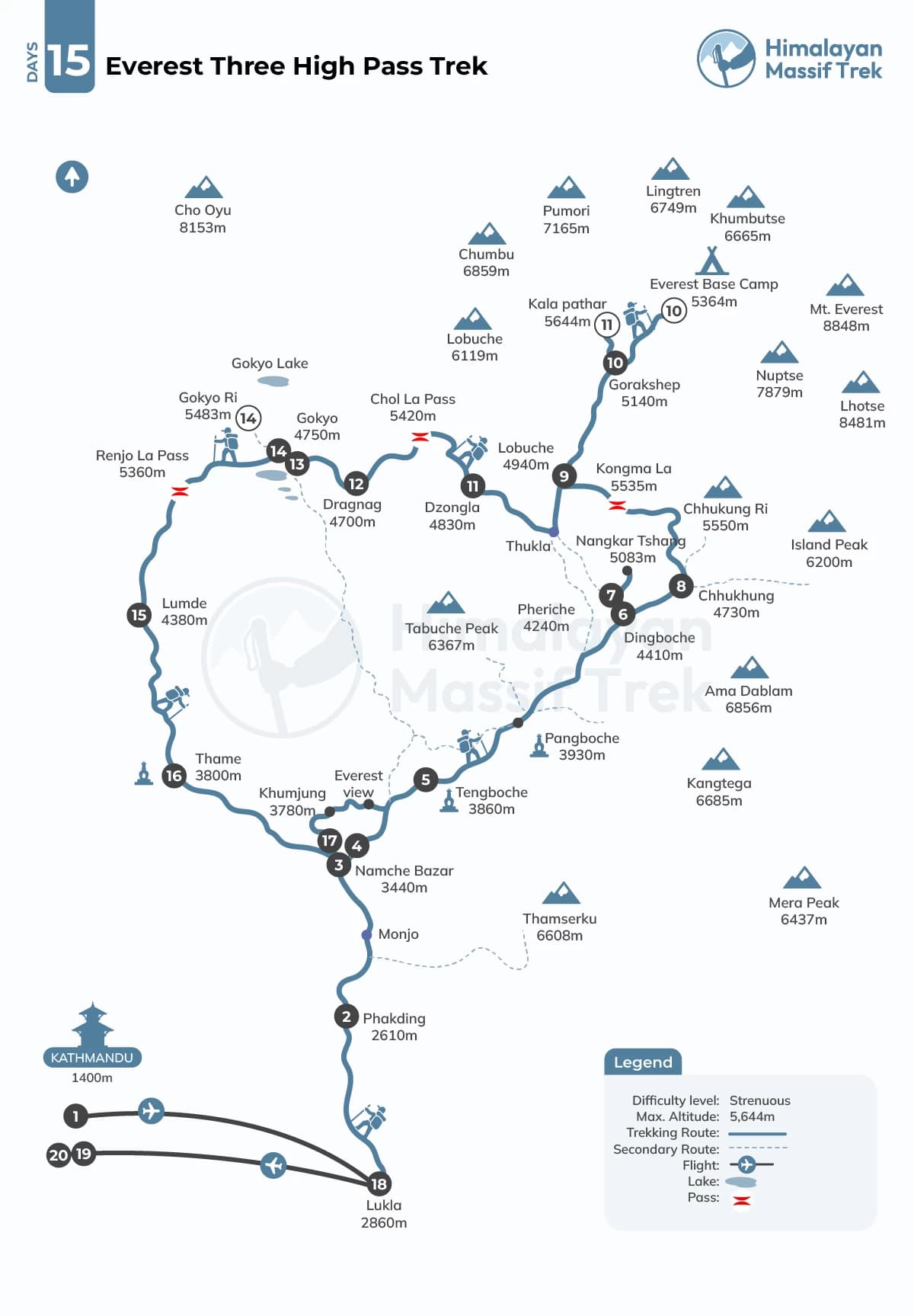

Cost Details
Accommodation:
- 2 Nights Hotel in Kathmandu ( 3-star hotel with BB plan)
- 17 nights comfortable lodge during the trek (Attached Bathroom in Namche-3 nights, Phakding-1 night, and Lukla-1 night)
Meals:
- 3 Standard meals a day ( Set of breakfast, Lunch and dinner)
- Farewell dinner in Kathmandu on the last night
Transportation and flights:
- Domestic airport pick up and drop
- Flight to Lukla from Kathmandu or Ramechhap and return
- Drop to Ramechhap and pick up from Ramechhap (during April, May, October and November)
Guide and porters:
- A highly experienced guide and an assistant guide if the group size is bigger than 6 people.
- A strong porter between two trekkers (he carries up to 20kg of baggage)
Permit and document:-
- Local government fees
- National park entry permit
Trekking gears:
- Sleeping bag and down jacket to use for the trek
- HMT T-shirt and duffel bag for free
- First aid kit
Miscellaneous:
- Salary, food and accommodation for guide and porters
- Government taxes and liabilities
- International airfare
- Travel Insurance and Nepal visa fee
- Lunch and dinner in Kathmandu
- Personal expenses include phone bills, cold and alcoholic drinks, and laundry bills.
- Personnel trekking gear
- Tipping for trekking guide and porters
To confirm your payment, a deposit payment is required, which is 30% of the total booking price. This deposit helps us secure permits, logistics, and other necessary arrangements for your trek.
We understand that plans can change, and we strive to be as flexible as possible. However, to cover operational costs, a cancellation fee applies. This is a percentage of your total booking price and is deducted from the deposit payment.
Cancellation Fees
Cancel 30% days before departure: 5% of the trip cost
Cancel between 10 to 30 days before departure: 10% of the trip cost
Cancel within 10 days of departure: 20% of the trip cost
If you need to cancel, please notify us as early as possible to reduce charges.
Rescheduling
Unexpected circumstances can disrupt travel plans, even if you still want to do the trip. To support our clients, we have generously waived all rescheduling fees. You can postpone and reschedule your trip at no additional cost, as long as the new departure date falls within one year of your original booking.
Upgrades
If you wish to upgrade your accommodation, transportation, or any other services not mentioned in the Trip Includes section, please be aware that these upgrades will incur additional costs. We can assist in arranging these options for you based on your preferences and availability.
Lukla Flights
Non-Refundable Flight Ticket: If you need helicopter evacuation or other means of transport due to altitude sickness or any other condition, your return flight ticket fare is non-refundable.
Refundable Flight Ticket: If the flight operator cancels your flight due to bad weather in Lukla, Kathmandu, or any other reason, your flight ticket fare is 100% refundable.
Dates & Availability
Private TripIf you don't find an appropriate date, you can propose a Preferred Departure Date, and we’ll ensure the trip runs as scheduled just for you.
Trip Gallery


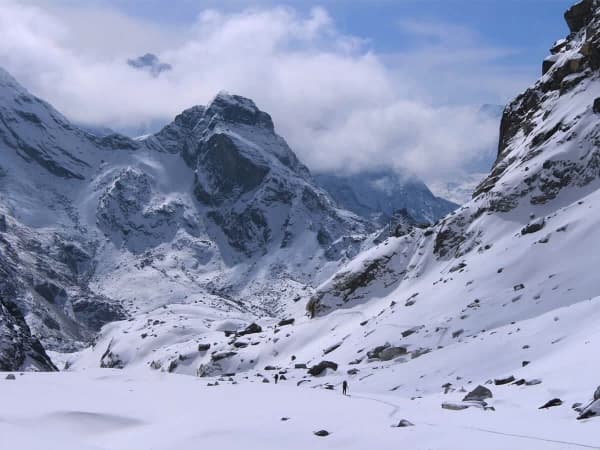
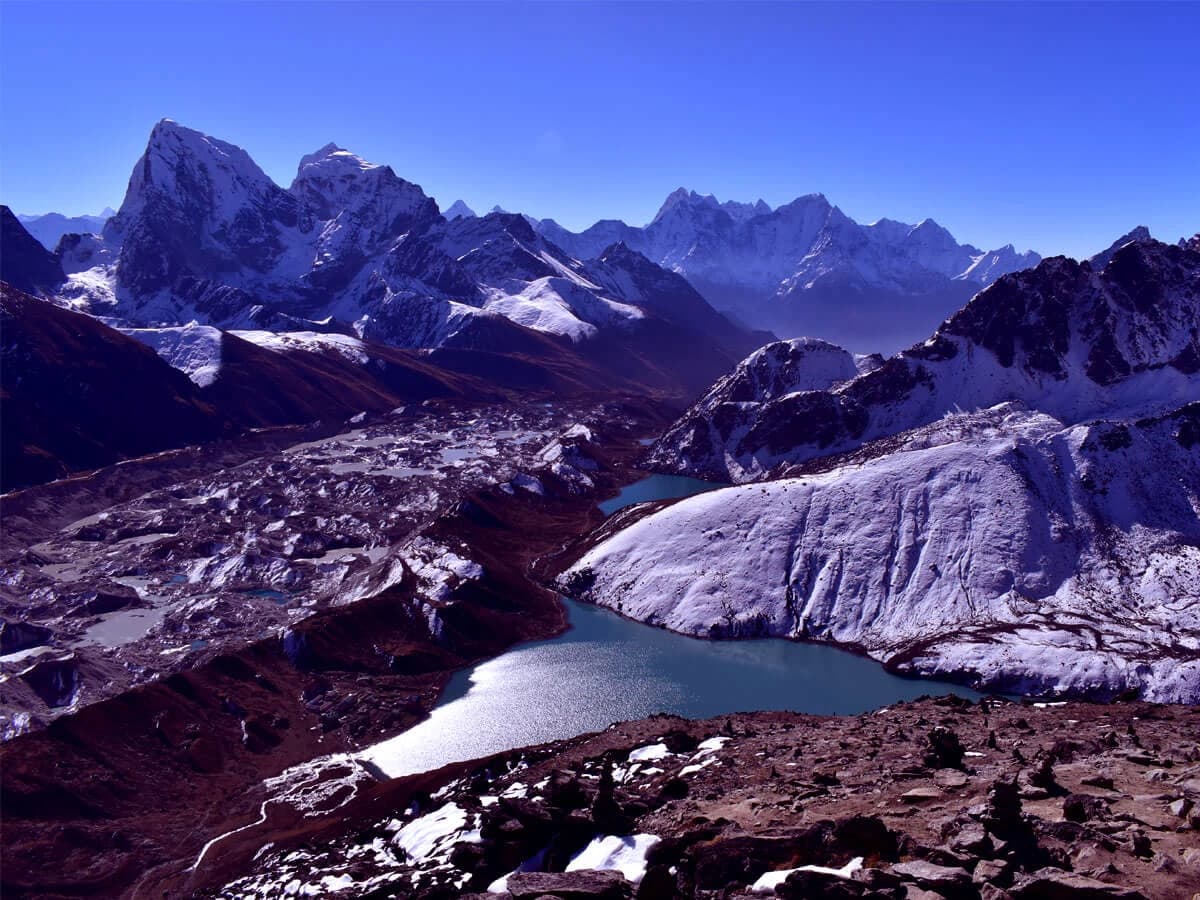
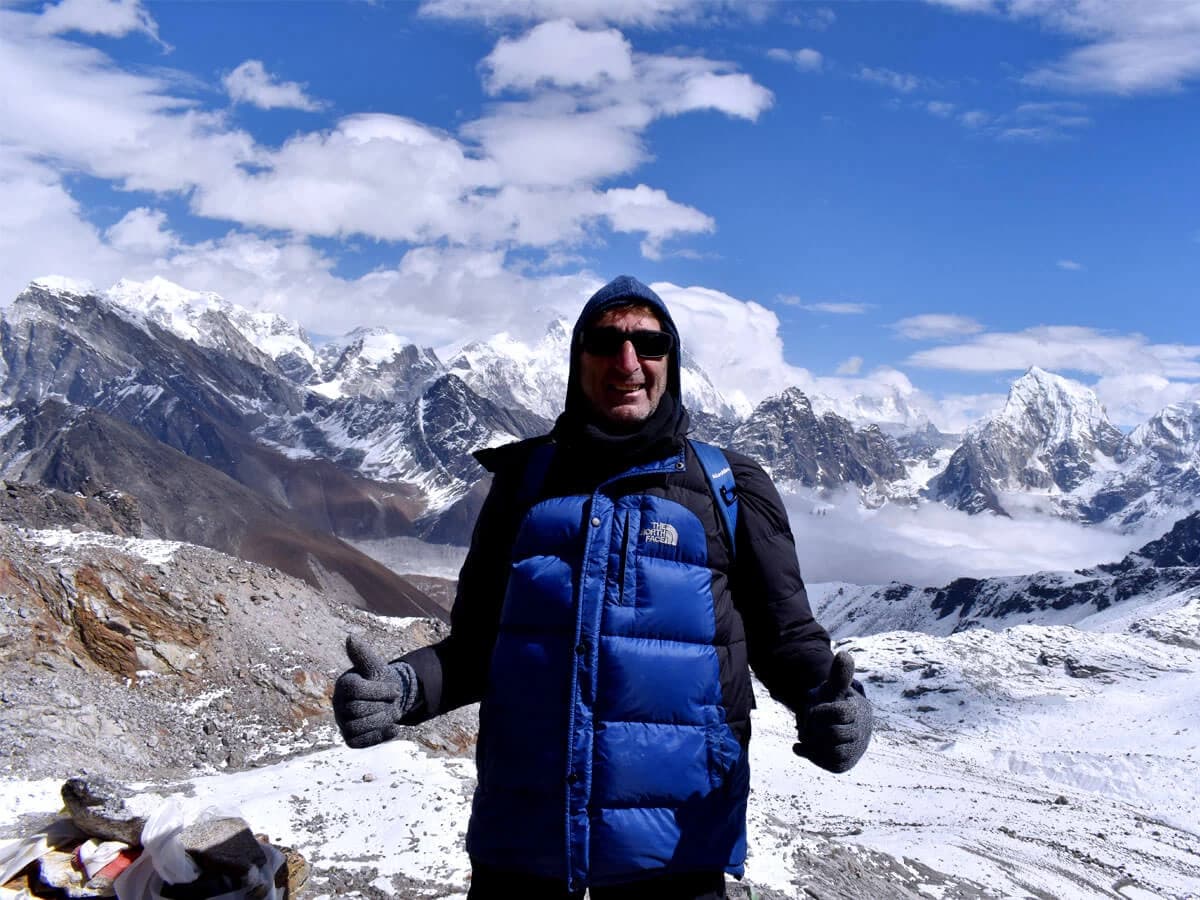

Essential Information
The Everest Three High Passes Trek is one of the most challenging treks in the Everest region, requiring excellent physical preparation and mental resilience. Covering high-altitude passes like Kongma La (5,535m), Cho La (5,420m), and Renjo La (5,360m), the trek demands stamina, strength, and a well-prepared body. A solid fitness plan is crucial to ensure you can enjoy the trek and handle its demands effectively.
Comprehensive Physical Preparation
Cardio Training:
Endurance is critical as you will be trekking for 6–8 hours daily, often at steep inclines. Incorporate activities like running, swimming, cycling, or hiking into your training routine. Aim for 4–5 sessions of cardio per week, gradually increasing intensity.
Stair Climbing:
If possible, practice climbing stairs or hills while wearing a weighted backpack. This closely simulates the strain you'll experience on steep ascents.
Interval Training:
Mix bursts of high-intensity cardio with slower recovery phases to mimic the varied effort levels required on the trek.
Strength Training:
Strengthening your muscles is essential for stability, balance, and the ability to carry a loaded backpack. Focus on:
Leg Strength: Include exercises like squats, lunges, step-ups, and calf raises to prepare for the continuous ascents and descents.
Core Stability: A strong core will help you maintain balance on uneven terrain. Add planks, Russian twists, and leg raises to your routine.
Upper Body Strength: Though your legs do most of the work, your arms and shoulders support your trekking poles and backpack. Push-ups, pull-ups, and dumbbell exercises are helpful.
Flexibility and Balance:
Flexibility and balance training prevent injuries and improve stability on rocky trails. Stretching exercises like yoga can keep your muscles supple. Include poses like downward dog and warrior pose to enhance flexibility and build lower body strength.
Trekking Practice:
Simulate trekking conditions by hiking with a loaded backpack. Start with shorter distances and gradually increase both the distance and weight. Practice on uneven terrains and trails with steep inclines or descents to build confidence and adaptability.
Breathing Exercises for High Altitudes
The thin air at high altitudes makes breathing more difficult, so improving lung capacity is essential. Regular practice of breathing exercises enhances oxygen intake and helps you cope better with altitude.
Diaphragmatic Breathing: Practice slow, deep breaths that expand your diaphragm. This maximizes oxygen intake and helps reduce fatigue at higher elevations.
Anulom Vilom (Alternate Nostril Breathing): This yoga technique can improve lung efficiency and calm your mind.
Pursed-Lip Breathing: Exhale slowly through pursed lips to regulate oxygen flow and reduce shortness of breath, especially during exertion.
Breath Retention Exercises: Gradually practice holding your breath for longer durations to prepare for the lower oxygen levels at high altitudes.
Dietary Preparation
Nutrition plays a crucial role in preparing your body for the trek and maintaining energy during the journey.
Before the Trek:
Iron-rich foods: Eat foods like spinach, beans, red meat, and fortified cereals to boost red blood cell production, which improves oxygen transport.
Carbohydrate Loading: Consume complex carbs like oats, brown rice, and whole grains to build glycogen reserves for sustained energy.
Healthy Fats and Proteins: Include nuts, seeds, eggs, and fish to support muscle recovery and endurance.
Avoid alcohol, smoking, and processed foods, as they can hinder physical performance and acclimatization.
During the Trek:
Stick to high-energy, easily digestible meals such as dal bhat, soups, rice, potatoes, and noodles.
Pack snacks like energy bars, trail mix, dried fruits, and chocolates for quick energy.
Stay hydrated by drinking at least 3–4 liters of water daily. Herbal teas and garlic soup, known for aiding acclimatization, are great additions.
Avoid alcohol and excessive caffeine, as they dehydrate the body and may worsen altitude symptoms.
Mental Preparation
Equally important as physical readiness is mental preparation. Trekking through the Everest Three High Passes can be exhausting and mentally taxing due to the high altitude, unpredictable weather, and demanding terrain.
Set Realistic Expectations: Understand that the trek is challenging, and focus on enjoying each day's progress rather than stressing about the end goal.
Practice Mindfulness: Engage in meditation or visualization techniques to stay calm and positive during tough moments.
Break the Trek into Smaller Goals: Focus on reaching the next milestone, such as a rest point or village, rather than the overall distance.
Build Mental Resilience: Prepare for setbacks like altitude sickness, fatigue, or slower progress. Keeping a positive attitude will go a long way in overcoming difficulties.
By combining structured physical training, breathing exercises, proper nutrition, and mental readiness, you'll be well-prepared to conquer the Everest Three High Passes Trek and make the most of this once-in-a-lifetime adventure.
Travel Insurance for Everest Three Pass Trek
Preparing for the Everest Three High Passes Trek goes beyond physical and mental readiness—it requires meticulous planning for emergencies. Trekking in the high-altitude Himalayas involves inherent risks, including altitude sickness, injuries, or extreme weather conditions. Having comprehensive insurance and an emergency plan is crucial for a safe and stress-free journey.
Travel insurance is a crucial aspect of preparing for the Everest Three High Passes Trek, especially given the high-altitude challenges and unpredictable conditions. When purchasing insurance, it's essential to ensure it covers trekking at altitudes up to 6,000 meters, as the Everest region exceeds this height.
One of the most important elements of travel insurance for trekkers is helicopter evacuation coverage. In the event of altitude sickness, injury, or other medical emergencies, getting immediate evacuation by helicopter can be life-saving, as medical facilities in the region are very limited.
Additionally, trip cancellations, delays, and lost baggage coverage are vital for trekkers heading to Lukla. Flights to Lukla, often referred to as one of the world’s most dangerous airports, are subject to weather delays and cancellations.
Ensuring your insurance policy covers these unexpected disruptions will give you peace of mind in case plans need to be changed. Some policies also cover trip interruptions if you have to cut your trek short due to unforeseen circumstances like illness or weather-related issues.
Different countries offer varying travel insurance options that cater specifically to trekkers heading to high-altitude regions. For example:
Australian trekkers can benefit from World Nomads or Cover-More travel insurance, both of which offer comprehensive coverage for high-altitude trekking, including up to 6,000 meters. These policies include emergency evacuation and medical coverage, trip cancellations, and baggage loss.
US trekkers may opt for Allianz Global Assistance or Travel Guard which offer policies with similar coverage tailored to adventurous activities, including trekking and evacuation coverage.
UK trekkers can choose from InsureandGo or Smith & Sons, which provide policies for trekking in high-altitude areas like the Everest region, including emergency medical care and helicopter evacuation.
Canadian trekkers often rely on Manulife or TuGo, offering coverage for trekking at high altitudes and ensuring emergency evacuation, medical treatment, and trip cancellation protection.
European trekkers can benefit from Europäische Reiseversicherung or AXA Assistance, which offers coverage that meets the requirements for trekking at altitudes up to 6,000 meters.
Note:
Before purchasing travel insurance, trekkers should carefully read the policy details to ensure that high-altitude trekking and emergency evacuation are included. It’s also crucial to check if specific activities such as glacier crossing, mountaineering, or climbing are covered if you plan to engage in those during the trek.
Environmental Responsibility
Environmental responsibility is crucial for trekkers in the Everest region, especially concerning waste management. Everest region is a UNESCO World Heritage site, home to rare flora and fauna, stunning landscapes, and the majestic Mount Everest.
To ensure its protection, trekkers have a shared responsibility to minimize their environmental impact and contribute positively to the conservation efforts in the area.
Initiatives like Carry Me Back, launched by Sagarmatha Next, encourage trekkers to carry out waste to aid in recycling efforts. Each trekker is encouraged to take back 1 kilogram of waste from the mountains, contributing to the reduction of environmental impact.
As visitors to Sagarmatha National Park, a UNESCO World Heritage site, trekkers bear the responsibility of preserving its unique natural and cultural heritage. Key responsibilities include:
Waste Management:
Dispose of waste responsibly by utilizing designated bins and participating in initiatives like Carry Me Back. By carrying out non-biodegradable waste like plastic bottles, wrappers, and other trash, trekkers help reduce pollution along the trails and protect the region’s pristine landscapes.
Respecting Local Culture:
Engage respectfully with local communities, honoring their traditions and customs.
The Sagarmatha Museum in Namche Bazaar promotes awareness about the cultural and environmental significance of the Everest region. Trekkers can support this initiative to help preserve the area's natural heritage and educate others about the importance of sustainable tourism and conservation.
Adhering to Regulations:
Comply with park regulations, including obtaining necessary permits and following designated trails to minimize environmental impact.
Everest Three High Pass Trek Equipment List
FAQs
To prevent frostbite or hypothermia, always layer your clothing, especially on your extremities. Wear moisture-wicking socks, gloves, and hats to keep warmth in. Avoid getting sweaty by regulating your layers. In freezing temperatures, be sure to cover all exposed skin and warm up frequently by moving.
If you're feeling unwell, it’s better to turn back to a lower altitude rather than pushing forward. Continuing at high altitudes without proper rest can worsen the condition, especially if you are suffering from altitude sickness. Always prioritize your health over completing the trek.
Yes, there are evacuation procedures, and if necessary, a helicopter evacuation can be arranged. The response time can vary, but in remote areas, it can take several hours or even a day for a helicopter to reach you. Always inform your guide about any health concerns, and carry a satellite phone for emergencies.
If you experience headaches, dizziness, nausea, or shortness of breath, these are early signs of altitude sickness. Progressing too quickly without proper acclimatization can increase the risk. It’s crucial to take rest days, stay hydrated, and ascend slowly to avoid these symptoms.
Trekking insurance that includes helicopter evacuation is highly recommended. Ensure it covers high-altitude trekking, medical evacuation, and emergency rescue. Verify the insurance details before departure to ensure coverage for medical emergencies or accidents in the Everest region.
To prevent stomach issues, stick to bottled water, avoid raw food, and wash your hands frequently. Bring anti-diarrheal medication, oral rehydration salts, and digestive enzymes to help in case of an upset stomach. If symptoms persist, descend to a lower altitude and consult a doctor.
Sleep can be disturbed at higher altitudes due to thinner air and lower oxygen levels. To ensure better sleep, keep warm, avoid caffeine in the evening, and create a comfortable sleeping environment. Consider using earplugs and an eye mask to block out noise and light in shared rooms.
Jet lag can occur, especially if you arrive from a different time zone. To minimize jet lag, get plenty of rest before your trek, stay hydrated, and adjust to local time by sleeping at the appropriate hours. You may also want to take it easy on the first few days in Kathmandu before heading out.
To stay hydrated at high altitudes, it's crucial to drink water regularly, even if you're not thirsty. At night, store your water bottle inside your sleeping bag or under blankets to prevent freezing. Consider using insulated bottles or water bladders to keep the water warm enough to drink.
The weather in the Everest region can be unpredictable, especially during the winter or monsoon seasons. While pass closures are rare, heavy snowstorms can make trails impassable temporarily. It’s crucial to build flexibility into your schedule and always follow the guidance of your guide regarding weather conditions.
The chance of a clear view of Mount Everest depends on the weather, which can be unpredictable. However, the high passes, especially Kongma La and Renjo La, offer excellent vantage points for Everest and other surrounding peaks. Always be prepared for changing weather conditions.
Weather-related delays are common in Lukla. If you miss your flight, you'll need to stay an extra night or more in Lukla until flights resume. Keep flexible plans in mind, as it's a risk of traveling in the region. Some trekkers opt to hike back to Phaplu as an alternative.
You may encounter wildlife such as yaks, Himalayan tahr, musk deer, and even the elusive snow leopard in some areas. Be cautious and respectful when approaching animals, and avoid feeding them. Your guide will help keep a safe distance from any wildlife you might encounter.
You can certainly bring your snacks like energy bars, nuts, and dried fruit. While tea houses provide basic meals, it’s always a good idea to carry some extra snacks for energy, especially on long trekking days or during times when meals may be delayed.
Eating nutrient-dense, high-carb foods (like rice, potatoes, and oats) will give you lasting energy. Avoid heavy, greasy meals and focus on balanced meals with proteins, fats, and carbohydrates. Stay hydrated and eat frequent small snacks (like energy bars and nuts) to keep energy up throughout the day.
It is recommended to carry water purification tablets or a portable filter, as river water may be contaminated. Boiling water or using purification systems (like iodine or UV purifiers) is the safest method for drinking water on the trek.
Sherpas are warm and welcoming, but it’s important to respect their culture. Always ask before taking photos of people, and be mindful of local customs, such as removing your shoes before entering homes and monasteries. Use polite greetings and show gratitude when interacting with locals.
It’s best to withdraw enough cash in Kathmandu before starting the trek. ATMs are available in Namche Bazaar, but they often don’t accept international cards. Ensure you have enough Nepali Rupees for your entire trek, and don’t rely on ATMs in the Everest region.
The most common mistakes include ascending too quickly, not acclimatizing properly, overpacking, and neglecting to drink enough water. To avoid these mistakes, follow a well-paced itinerary, stay hydrated, pack light but with the essentials, and listen to your guide’s advice for safety and well-being.
If you have free time in Kathmandu, explore cultural sites like Boudhanath Stupa, Swayambhunath (Monkey Temple), Pashupatinath Temple, and Durbar Square. You can also visit Thamel for local shopping and cafes, or take a day trip to Nagarkot for panoramic Himalayan views.
I. Expertise and Local Knowledge
When you book the trek with Himalayan Massif Trek, you're choosing a team of experienced guides who have in-depth knowledge of the Everest region. The guides are locals who know the culture, terrain, and trails better than anyone else. With decades of trekking expertise in the Himalayan belt, they will ensure you have a safe and enriching journey throughout your trek.
II. Authentic Local Experiences
We offer you the chance to experience authentic Sherpa villages. Along the way, you'll enjoy traditional Sherpa meals, providing you with a true taste of local culture. You’ll also gain insights into the traditions, lifestyle, and hospitality of the people from the Everest region. Hence, this makes your trek feel like more than just a hike - it’s a cultural adventure.
III. Value for Money
Great value for money is another reason you should book your Three High Passes Trek with Himalayan Massif Trek. We offer competitive prices with no hidden costs. Everything is included, from your permits and comfortable accommodations to your delicious meals. Plus, we have special discounts for groups and repeat travelers.
IV. Environmental Responsibility
Our company is committed to environmental responsibility, ensuring that trekking in the Everest region has minimal impact on the environment. By using eco-friendly trekking practices and supporting local suppliers, we help preserve the beauty of the Himalayas. We also prioritize sustainable travel, assuring that local communities and the stunning landscape remain protected for future generations.
- Expertise in High-Altitude Trekking Adventures
- Over 18 Years of Experience in The Himalayas
- Authorized and Reliable Trekking Partner
- Trusted by Thousands of Adventurers Worldwide

The Three Passes Trek was the ultimate Himalayan adventure. The trails were challenging, but the views were worth every step. The team at Himalayan Massif...
This trek was a true test of endurance, but the sense of accomplishment was incredible. The guides were experienced and made sure we were safe...
The Three Passes Trek offered some of the most stunning scenery I’ve ever seen. The team was professional and made sure we had a great...
